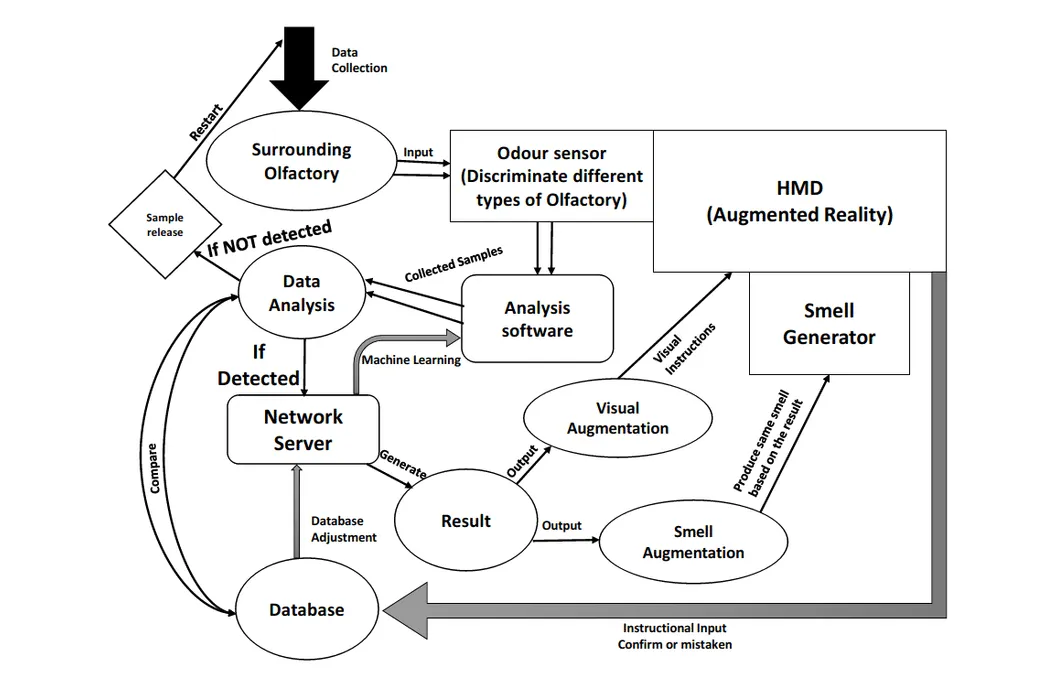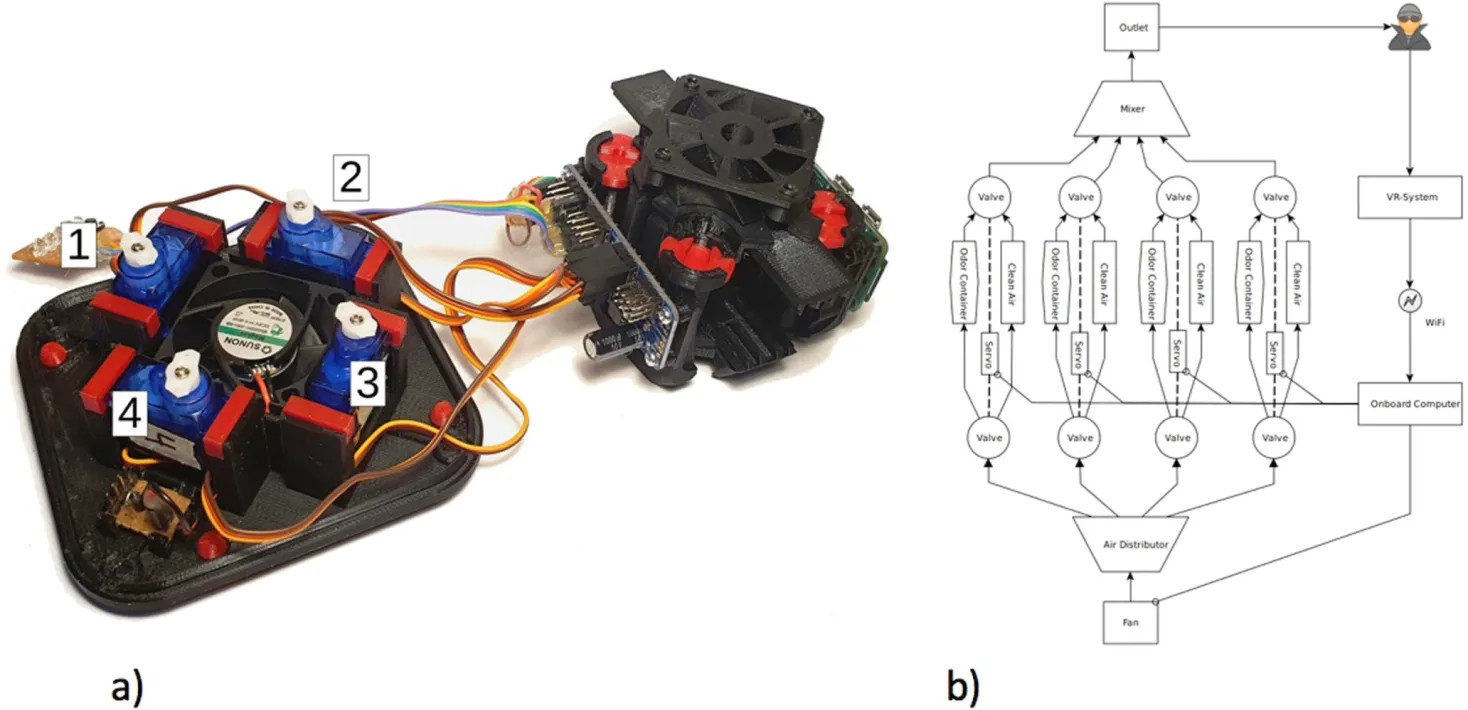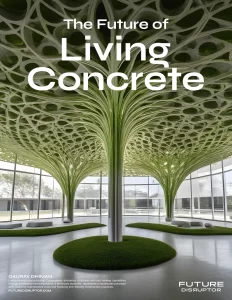The Future of Smelly Virtual Reality (VR)

Smelly Virtual Reality (VR) technology is a term that refers to the use of devices that can generate and deliver different scents and odors in the virtual world. These devices aim to enhance the immersion and realism of VR experiences by stimulating the sense of smell, which is often neglected in VR. Some examples of smelly VR technology are:
- The ION device contains vials of different scents that can be mixed and matched to create various odors.
- The olfactometer device uses valves to make a combination of odors with virtual objects and can alter the intensity of the scents.
- The wireless olfactory feedback system integrates odors into VR/AR using miniaturized odor generators that can heat perfumed paraffin wax.
It is also known as or related to olfactory VR, multisensory immersion, scentscape, aromaverse, taste and touch XR, 4D immersion, atmospheric VR, immersive storytelling, emotional engagement, moodscape, experiential VR, sensory storytelling, scentsational VR, next-gen immersion, hyperreal simulation, olfactory interface, advanced haptic feedback, multimodal VR, nosedive VR, stinkyverse, sniff and sim, aromageddon, and ode to olfaction.

Practical Applications
Some of the practical applications of smelly VR technology are:
- 4D movie watching: It can enhance the realism and immersion of watching movies in VR by adding scents that match the scenes, such as flowers, food, or smoke.
- Medical treatment: It can help patients who suffer from anosmia (loss of smell) regain their sense of smell through VR training. It can also help with mental health issues, such as anxiety or depression, by providing aromatherapy or pleasant smells in VR.
- Online teaching: It can enrich the learning experience of students who take online courses in VR by allowing them to smell the objects or environments they are studying, such as plants, animals, or historical places.
- Gaming: It can make gaming more fun and engaging by adding smells that correspond to the game world, such as gunpowder, blood, or fire. It can also create new gameplay mechanics, such as finding clues or enemies by following their scents.
Importance for Our Future
Smelly VR is important for our future because it can:
- Enhance the realism and immersion of VR experiences by stimulating the sense of smell, which is often neglected in VR.
- Provide new entertainment, education, and therapy methods by creating multisensory environments that evoke emotions, memories, and curiosity.
- Enable social interactions and communication in VR by allowing users to share and perceive each other’s scents, such as perfumes, foods, or emotions.
It can also help us appreciate the diversity and beauty of our natural world and the threats and challenges it faces due to climate change and pollution. By smelling the virtual world, we may become more aware and responsible for our real one.

How Does It Work?
Here are some steps of how smelly VR works:
- The user wears a VR headset that has a device attached to it that can produce smells. The device can be either a small cartridge that fits over the nose or a face mask that covers the mouth and nose.
- The device contains a mechanism that can create smells, such as miniaturized odor generators, vials of scents, or an olfactometer.
- The device is connected to a computer or a controller that can activate the mechanism in the VR environment when a smell is needed. For example, when the user picks a virtual rose, the device heats a wax that contains the rose scent.
- The device delivers the smell to the user’s nose using a fan, a radiator, or a valve. The smell is synchronized with the VR scene and the user’s actions. For example, when the user moves the rose away from the nose, the device cools down the wax and stops the smell.
- The user can smell the virtual world and experience a more realistic and immersive VR sensation. The smell can also affect the user’s emotions, memories, and curiosity.
Evolve in the Future
Here are some of the ways smelly VR can evolve in the future:
- Improve the safety and comfort of the devices that produce smells, such as lowering the temperature, reducing the wires, and increasing the compatibility with existing VR headsets.
- Expand the range and variety of scents that can be generated and delivered, such as using more natural and complex odors or creating personalized and customized smells.
- Develop new ways of transmitting and receiving odors in online chats, social media, or e-commerce, such as digital smell technology, chemical interfaces, or scent-based emojis.
- Evolve by leveraging advances in the entertainment industry, the medical field, and online VR platforms.
Help Organizations/Enterprises
Smelly VR technology can help organizations and enterprises in various ways, including:
- Improve the effectiveness and efficiency of training and education by providing realistic and immersive scenarios that stimulate the sense of smell, which can enhance memory, learning, and performance.
- Enhance the customer experience and satisfaction by offering multisensory and interactive products and services that appeal to the sense of smell, which can influence emotions, preferences, and behaviors.
- Increase employees’ and teams’ innovation and creativity to enable them to explore and experiment with different scents and odors in the virtual world, which can inspire new ideas and solutions.
- Gain a competitive edge and create value in their respective fields and markets.

Driving Adoption
Some of the factors that are driving smelly VR technology adoption are:
- There is an increasing demand for realistic and immersive VR experiences that stimulate the sense of smell, which is often neglected in VR.
- There is a growing availability and affordability of devices that can generate and deliver different scents and odors in the virtual world, such as miniaturized odor generators, vials of scents, or olfactometers.
- Smelly VR has diverse and innovative applications in various fields and sectors, such as entertainment, education, health care, retail, and real estate.
Operational Challenges
Some of the challenges in operationalizing smelly VR technology are:
- Difficulty reproducing real-world odors accurately and realistically, as smells are complex and subjective phenomena that depend on many factors, such as the chemical composition, concentration, duration, and context of the odor.
- Safety and comfort of the users, as smells can cause allergic reactions, headaches, nausea, or irritation, especially if they are too strong, frequent, or unpleasant.
- Compatibility and integration of the devices that produce smells with existing VR headsets and platforms, as they may require additional wires, batteries, or software, can affect the VR system’s usability, portability, and cost.
Success Stories
Some of the success stories of smelly VR technology are:
- A Vermont-based startup, OVR Technology, developed a device that can snap onto a VR headset and produce smells by heating perfumed wax. The device can create hundreds of scents matching the VR scenes, such as picking and smelling a virtual rose.
- A team of researchers from Hong Kong and Beijing created two wearable interfaces that can generate and deliver odors in VR using miniaturized odor generators. The interfaces can adhere to the skin, strap on beneath a headset, and reproduce multiple scents within seconds.
- A group of scientists from the University of Chicago and the University of Illinois at Urbana-Champaign developed a chemical interface that can transmit and receive odors in online chats. The interface can send scented messages or emojis to other users or smell the virtual environment.
- Feelreal launched a VR mask that can produce smells, wind, heat, water mist, and vibration. The mask can enhance the VR experience by adding sensory effects corresponding to the VR content, such as feeling the breeze or smelling the ocean.

Types
Different types of smelly VR use various methods and devices to generate and deliver smells in the virtual world. Some of the main types are:
- Olfactometer: This type of device uses valves to make a combination of odors with virtual objects and can alter the intensity of the scents. It can create various smells by mixing different scents from vials or cartridges.
- Miniaturized odor generator: This device uses miniaturized containers filled with perfumed paraffin wax that can heat up and release smells when activated. It can produce multiple odors within seconds and can be attached to the skin or a face mask.
- Chemical interface: This device uses chemical reactions to transmit and receive odors in online chats or social media. It can send scented messages or emojis to other users or smell the virtual environment.
Ethical Concerns
Some of the ethical concerns with smelly VR technology are:
- The potential mental health risks of VR such as depersonalization, derealization, or addiction.
- The personal neglect of users’ bodies and natural physical environments, such as hygiene, nutrition, or social relationships.
- The representation and inclusion of marginalized groups, such as minorities, women, or people with disabilities, in VR content and design.
- The social isolation and over-reliance on fantasy rather than real-world interactions may affect users’ emotional and psychological well-being.
- The exploitation and abuse of VR replicas, such as sexual or violent acts, without the consent or knowledge of the person the replica is based on.
- New forms of virtual crime, such as hacking, stealing, or blackmailing, may occur in VR environments.
- The moral responsibility and accountability of VR designers, developers, and users who may create or experience unethical scenarios in VR.
These ethical concerns require careful consideration and regulation, which may significantly impact individuals and society. Like any other technology, it can be used for good or evil, depending on the choices and actions of its creators and users.
Governance and Regulation
Possible ways to govern and regulate smelly VR are:
- Establish clear and consistent definitions and standards for smelly VR technology, such as what constitutes a smell, how to measure its intensity and quality, and how to ensure its safety and compatibility.
- Develop ethical principles and guidelines for smelly VR technology, such as respecting users’ privacy, consent, and preferences, avoiding harmful or offensive smells, and ensuring the diversity and inclusion of different cultures and groups.
- Create legal frameworks and mechanisms for smelly VR technology, such as protecting the intellectual property rights, data security, and liability of creators and users, resolving disputes and conflicts, and enforcing laws and regulations.
- Fostering collaboration and innovation among stakeholders of smelly VR technology, such as businesses, governments, researchers, civil society, and users, to share best practices, learn from each other, and co-create solutions.
History
The history of smelly VR technology can be traced back to the following milestones:
- 1868: The first attempt to introduce smells into entertainment was made by a London stage performance that sprayed scents from Rimmel, a fragrance company, into the crowd.
- 1939: Hans E. Laube invented Smellovision, a device that used pipes and vials of odors to waft smells to moviegoers through pipes hidden beneath their seats. He demonstrated it at the New York World’s Fair.
- 1960: Smellovision was used for the film Scent of Mystery, a thriller that challenged viewers to identify the villain through olfactory clues. It faced a rival technology, AromaRama, which dumped scents into the theater’s air conditioning.
- 1990s: It emerged as a research topic in the first wave of VR, as improved displays and 3D-rendering techniques made head-mounted displays viable. Several devices and systems were developed to create smells in VR, such as the FiVe FiRe, which used an “odorpak” to mimic the smell of burning debris.
- 2020s: It gained more attention and innovation in the second wave of VR as wireless and wearable devices became more available and affordable. New methods and mechanisms were invented to generate and deliver smells in VR, such as miniaturized odor generators, chemical interfaces, or scent-based emojis.
Tools and Services
Smelly VR tools and services are products and platforms that use devices to generate and deliver different scents and odors in the virtual world:
- OVR Technology: A Vermont-based startup that developed a device that can snap onto a VR headset and produce smells by heating perfumed wax. The device can create hundreds of scents matching the VR scenes, such as picking and smelling a virtual rose.
- Miniaturized odor generator: A device that uses miniaturized containers filled with perfumed paraffin wax that can heat up and release smells when activated. It can produce multiple odors within seconds and can be attached to the skin or a face mask.
- Chemical interface: A device that uses chemical reactions to transmit and receive odors in online chats or social media. It can send scented messages or emojis to other users or smell the virtual environment.
- Feelreal: A VR mask that can produce smells, wind, heat, water mist, and vibration. The mask can enhance the VR experience by adding sensory effects corresponding to the VR content, such as feeling the breeze or smelling the ocean.
How to Get Started?
To start with smelly VR technology, you will need to:
- Choose a device compatible with your VR headset that fits your preferences and budget. You can find examples of smelly VR technology tools and services on the web, such as OVR Technology, Feelreal, or [Smell VR].
- Select software that can synchronize the smells with the VR content, such as games, movies, or educational programs. You can also create VR content and add smells using Unity or Unreal Engine platforms.
- Adjust the intensity and duration of the smells according to your comfort and sensitivity. Avoid smells that are too strong, frequent, or unpleasant, as they may cause allergic reactions, headaches, nausea, or irritation.
- Experiment with different scents and odors in the virtual world and discover how they affect your emotions, memories, and curiosity. You can also share and perceive other users’ scents, such as perfumes, foods, or emotions, in online chats or social media.
- Be aware of smelly VR’s ethical and social implications, such as users’ privacy, consent, and preferences, the representation and inclusion of different cultures and groups, and the moral responsibility and accountability of creators and users.
Related Terms
Some of the terms related to smelly VR technology are:
- Olfactory: Relating to the sense of smell or the organs of smell.
- Olfactometer: A device that uses valves to make a combination of odors with virtual objects and can alter the intensity of the scents.
- Miniaturized odor generator: A device that uses miniaturized containers filled with perfumed paraffin wax that can heat up and release smells when activated.
- Chemical interface: A device that uses chemical reactions to transmit and receive odors in online chats or social media.
- Digital scent technology: The engineering discipline dealing with olfactory representation. It is a technology to sense, transmit, and receive scent-enabled digital media.
Learn more
Research Papers
- New research aims to bring odors into virtual worlds: This paper describes a new method of creating and delivering smells in VR using miniaturized odor generators that can be attached to the skin or a face mask. The paper also discusses the safety and comfort of the device and the possible uses and implications of smelly VR technology.
- Unlocking The Power of The Underrated Digital Smell Technology: This paper outlines the history and development of digital smell technology and the various fields and sectors that can benefit from it. The paper also highlights the challenges and opportunities of digital smell technology and suggests future directions and recommendations.
- May I Smell Your Attention: Exploration of Smell and Sound for Visuospatial Attention in Virtual Reality: This paper investigates the effect of smell and sound on visuospatial attention in VR. The paper implements the Bells Test, a neuropsychological test to assess attentional and visuospatial disorders in VR. The paper also examines the influence of different types and intensities of smells and sounds on the performance and experience of the test.
- The Future of Learning Multisensory Experiences: Visual, Audio, Smell and Taste: This paper chapter from Advances in Human Factors in Training, Education, and Learning Sciences explores how the sense of smell and taste can be integrated into an educational VR interface.
Courses
- Introduction to Virtual Reality: This course, offered by the University of Chicago, explores the role of smell in VR and how it can enhance the realism and immersion of VR experiences. The course covers the physiology and psychology of smell, the history and development of smelly VR technology, the ethical and social implications of smelly VR technology, and the design and evaluation of Smelly VR systems and applications.
Books
- Reading List: 50 Sci-Fi Books Featuring AR and VR Technology: This list from UploadVR includes 50 science fiction books with significant AR and VR presence, some of which also involve smell.
- 20 Best Virtual Reality Books of All Time: This list from BookAuthority ranks the best VR books based on recommendations from experts and celebrities, some of which also feature smell.
Documentaries
- 17 Must Watch VR Documentaries!: This is a list of VR documentaries that cover various topics, including smelly VR technology. Some of the documentaries in this list are The Smell of the Moon, which explores how NASA is trying to recreate the smell of the lunar surface for astronauts, and The Scent of Memory, which examines how smell can trigger memories and emotions in VR.
I hope you enjoyed this insightful discourse. I believe that open dialogue and diverse perspectives are essential for fostering a deeper understanding of complex issues. Therefore, encourage you to share your thoughts and opinions in the comments below. Engage with other readers, challenge assumptions, and contribute to a rich and meaningful discussion. Your insights are valuable, and welcome you to participate actively in this intellectual exchange.
Together, we can explore new ideas, expand our horizons, and generate fresh perspectives.

Learner-in-Chief at Future Disruptor. A futurist, entrepreneur, and management consultant, who is passionate about learning, researching, experimenting, and building solutions through ideas and technologies that will shape our future.
Subscribe to the Future Disruptor newsletter.






Leave a Reply